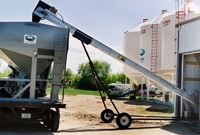March 24, 2011

Just like the rest of society, the seed business is going paperless. The paper seed bag is quickly being replaced by bulk seed delivery and storage containers.
With the decrease in the use of paper bags comes savings in other components. “As an industry, every 1% increase in bulk usage for soybeans means 800,000 less paper bags, 16,000 fewer pallets, thousands of pounds of shrink wrap that’s not needed, and saving thousands of hours not riding a forklift,” says Gary Wietgrefe, soybean bulk manager for Syngenta. “Handling paper bags can be much more time consuming for the seed company as well as the producer ripping open bags to fill a planter.”
Soybeans go bulk first
The move away from paper bags has been dramatic for the soybean seed business. Seed companies report that a significant portion of their soybean seed sales is delivered via bulk containers. Corn seed is experiencing the trend away from seed bags, too, but not at the same rate as that for soybeans.
“What we are seeing now is an evolution in the soybean seed market,” says Al Carlson, soybean product manager for Dow AgroSciences. “The amount of seed delivered in bulk is currently limited by the number of dealers and producers who have the on-farm capacity to handle the seed. But that is quickly changing as the industry changes the way seed is delivered. Some will want hard-sided boxes, while others will want bulk delivery.”
“For 2011, the soybeans delivered through our TruBulk system locations will exceed the amount we deliver in paper bags,” Wietgrefe says. “We are seeing a dramatic increase in the number of producers requesting bulk delivery of soybean seed directly to the farm, bypassing the bag altogether.”
The change is occuring more quickly in some areas of the country than in others. For example, Wietgrefe says, more than half of the soybeans sold by Syngenta in the Southeast are still packaged in paper bags, while less than 5% are sold in bags in the Dakotas.
A benefit of bulk seed delivery is flexibility. “With our TruBulk delivery system, we can sell exactly what is needed for the field,” Wietgrefe says. “If a producer needs 136 units, we can sell and treat that amount and deliver it as one bulk package.”
Another reason for the significant shift to bulk soybeans is the amount of seed that must be handled. One bag of soybean seed plants just one acre. A bag of corn seed will cover about 2.5 acres. Bulk soybean seed simply becomes more convenient for growers.
Seed treatments
Bulk handling also works well with seed treatments because seed dealers can add treatments just prior to delivery. “With the variety of seed treatments available, producers can choose what they want to use just prior to planting, and the sales rep can apply and repackage seed quickly,” says Terry Gardner, head of North American product marketing, Pioneer Hi-Bred. “That chore is much more difficult if you have to handle bags.”
At Pioneer, less than 20% of soybean seed is delivered in soybean bags. “Our ProBulk has been popular with our sales reps,” Gardner says. “They own bins and can repackage the seed back to customers into ProBoxes or customer tenders. The amount of soybean seed we deliver in ProBulk has tripled in the past five years.”
However, there’s additional handling with bulk seed delivery systems. “Our ProBox system is popular, and we are buying more boxes,” Gardner says. “But along with those boxes comes the need to bring the boxes back from the farm, warehouse space to store the boxes, logistics to fill, fix, and wash the boxes. The move to bulk has meant an investment so we can meet our customer demand. Our plants are prepared to meet our packaging needs.”
Bulk delivery requires some adjustment for the industry — from retooling seed planters to handle the bulk systems, to new storage.
Trend continues with corn
The shift to bulk has not been as dramatic for corn seed as it has been for soybean seed. But the trend is still there.
“For corn, we have seen significant demand increases for seed being delivered with our SmartBox system,” says Rick Henley, corn product manager, Dow AgroSciences. “We have also met with several planter manufacturers, and they tell us that 75% of new planters have center-fill units. We are always looking to meet customer demand, as well as manufacturer direction, and the trend is clearly to more bulk delivery.”
About 30% of Pioneer Hi-Bred’s corn seed is sold in bulk packaging today compared to only 15% in 2005, Gardner reports. “Producers want to be able to quickly and conveniently fill their planters,” he says. “We expect a steady increase for corn seed to be delivered in bulk, as farm sizes get larger and planters get bigger. Our sales are clearly heading in that direction.”
Companies add that the advent of refuge-in-a-bag products could accelerate the amount of corn seed sold in bulk. Growers will take advantage of seed with the built-in refuge, which eliminates the need for separate corn refuge hybrids.
About the Author(s)
You May Also Like






